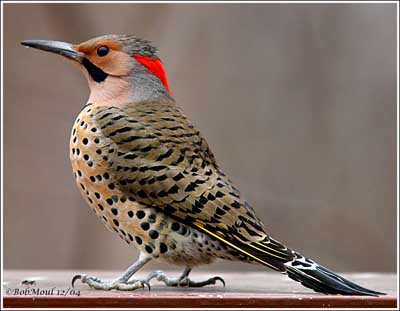
Northern Flicker
Colaptes auratus
Piciforme Order – Picidae Family
BIOMETRICS:
Length : 30 à 35 cm
Wingspan : 42 à 51 cm
Weight : 110 à 170 g
LONGIVITY: Up to 9 years
DESCRIPTION:
Northern Flicker has a grey-brown barred back, and white rump. Male has a tan head, grey crown, red nape, black moustache and a black crescent on the breast. The underparts are light tan with dense black spotting (lower breast, flanks and belly). The tail is black-tipped. Undertail coverts and wing lining are yellow.
In flight, we can see its white rump patch and its largely yellow underwing.
The bill is strong, straight and chisel-shaped. The greenish-grey legs are short, and the feet are zygodactylous. Claws are long.

MALE
Race auratus
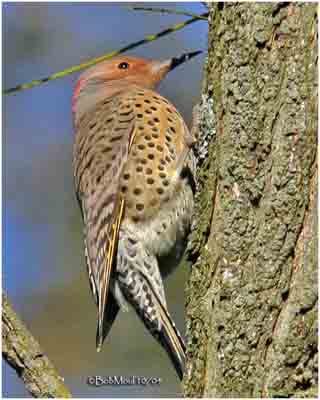
Female is slightly smaller and lacks the black malar stripe. The black breast crescent is smaller.
FEMALE
Race auratus
Juvenile resembles adults but it has greyer head and some bars on crown, black lores, smaller black breast crescent, more spotted plumage and dull yellow underparts.
We find several subspecies which differ by head colours, mainly on malar stripe (black, red or chestnut), crown (grey or chestnut) and by the red nuchal patch which may be absent. They also differ by the size.
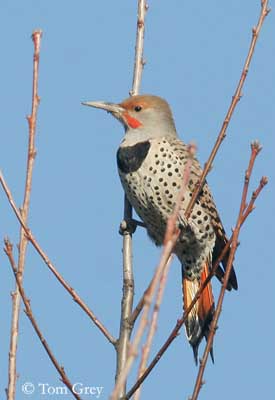
MALE
Race cafer
VOICE: SOUNDS BY XENO-CANTO
Northern Flicker sings while is flying. Its song is a loud “wick-wick-wick-wick-wick”. Individual notes sound like a loud ‘klee-yer” and a squeaky “flick-a, flick-a, flick-a”.
HABITAT:
Northern Flicker lives in wooded areas, with stand of dead trees. It likes also open areas, forest edges, clearings, burnt areas, agricultural lands and residential areas, parks and large gardens.
RANGE:
Northern Flicker ranges from Alaska to Quebec, and South throughout the entire United States. It winters in the southern part of its range, and in northern Mexico. We can find it on Grand Cayman, Cuba and as far south as the highlands of Nicaragua.
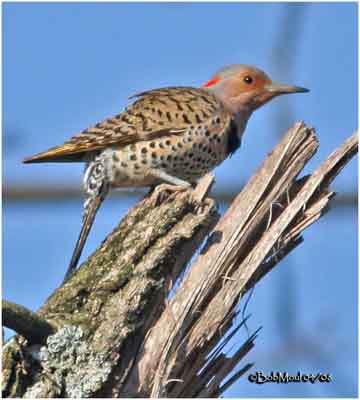
FEMALE
Race auratus
BEHAVIOUR:
Northern Flicker male recognizes female by sight. Pairs often mate for life, and typically return to the same area for nesting.
It can have aggressive displays to protect its mate or territory. It may point the bill at a rival, with the head tilted forward, or pecks at an opponent. For a more aggressive display, a Northern Flicker may use side to side head and body movements against an opponent. A “head-bobbing” display may be used too. Sometimes, these displays are accompanied by tail spreading.
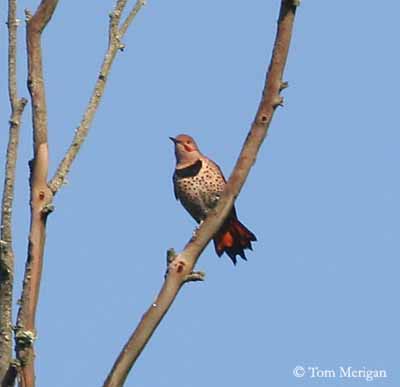
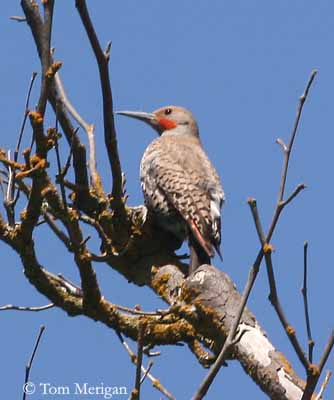
MALE
Race cafer
It prefers to feed on the ground, where it hops awkwardly. To feed, it uses its long barbed tongue to lap up the ants.
We can find it on dead trees where it moves as tits.
It feeds mainly on ants and larvae, but also other insects, spiders, molluscs and some crustaceans. In winter, it consumes fruits, berries, seeds and acorns.
Usually seen alone, in pairs or in family groups, it may feed in small flocks during the migrations.
The Northern Flicker is one of the few North American woodpeckers that are strongly migratory, mainly the northernmost populations.
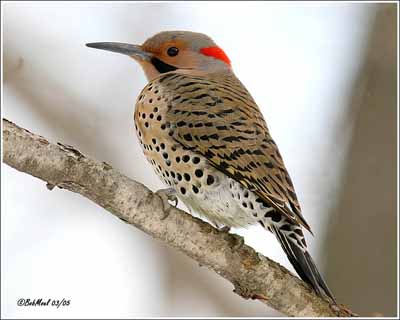
MALE
Race auratus
FLIGHT:
Northern Flicker has a deeply undulating flight.
REPRODUCTION:
Breeding season occurs from February to July.
Northern Flicker’s nest is excavated in dead tree trunks, or in a dead part of live trees, or telephone poles. It may be found in unlined tree cavities, or in earthen banks of termite’s nests. The nest is usually built below 3 meters.
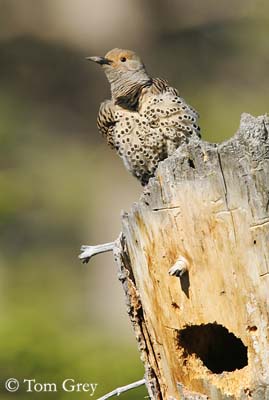
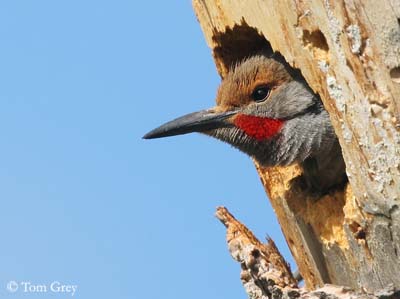
The female lays 3 to 12 white and glossy eggs per clutch. Both parents incubate the eggs for 11 to 16 days. Northern Flickers may have one or two clutches per season. Both parents care for nestlings. After the nestling period of 25 to 28 days, the young remain with their parents for some times, about 15-20 days, begging and calling for food.
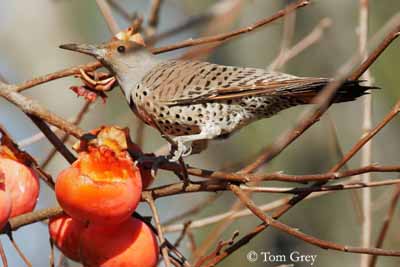
FEMALE
Race cafer
DIET:
Northern Flicker main food is ants. But they consume others insects, including grasshoppers, crickets, termites, wasps, aphids, beetles and their larvae, caterpillars and spiders.
They consume also cherries and berries, and weed seeds, acorns and other nut kernels.
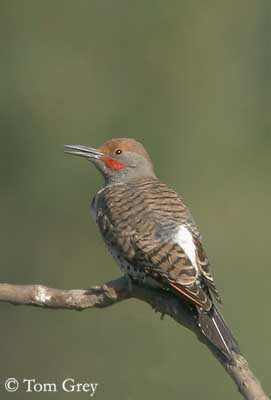
MALE
Race cafer
PROTECTION / THREAT / STATUS:
Young in the nest are vulnerable to predators such as racoons, squirrels and snakes. Later, they are preyed upon by birds of prey (Cooper ’s Hawk, and Sharp-shinned Hawks in North America).
Populations are not seriously endangered by human activities, but they loose their habitat.
Northern Flicker helps to control the populations of their preys, especially ant’s populations, and aphids.
Ang: Northern Flicker
All : Goldspecht
Esp : Carpintero Escapulario
Ital : Picchio dorato
Nd : Goudspecht
Russe : Золотой дятел
Sd: Guldspett
Photographs by Tom Grey (race cafer)
His website: Tom Grey's Bird Pictures
Photographs by Bob Moul (race auratus)
His website: Nature Photography
Photographs by Tom Merigan (race cafer)
His website: Tom Merigan’s Photo Galleries
Text by Nicole Bouglouan
Sources:
HANDBOOK OF THE BIRDS OF THE WORLD Vol. 7 by Josep del Hoyo-Andrew Elliott-Jordi Sargatal – Lynx Edicions – ISBN: 8487334377
FIELD GUIDE TO THE BIRDS OF NORTH AMERICA by National Geographic Society - National Geographic Society - ISBN: 0792274512
All About Birds (Cornell Lab of Ornithology)
Bird Web (Seattle Audubon Society)
What Bird-The ultimate Bird Guide (Mitchell Waite)
Wikipedia (Wikipedia, The Free Encyclopedia)
Birds of Nova Scotia (Robie Tufts)